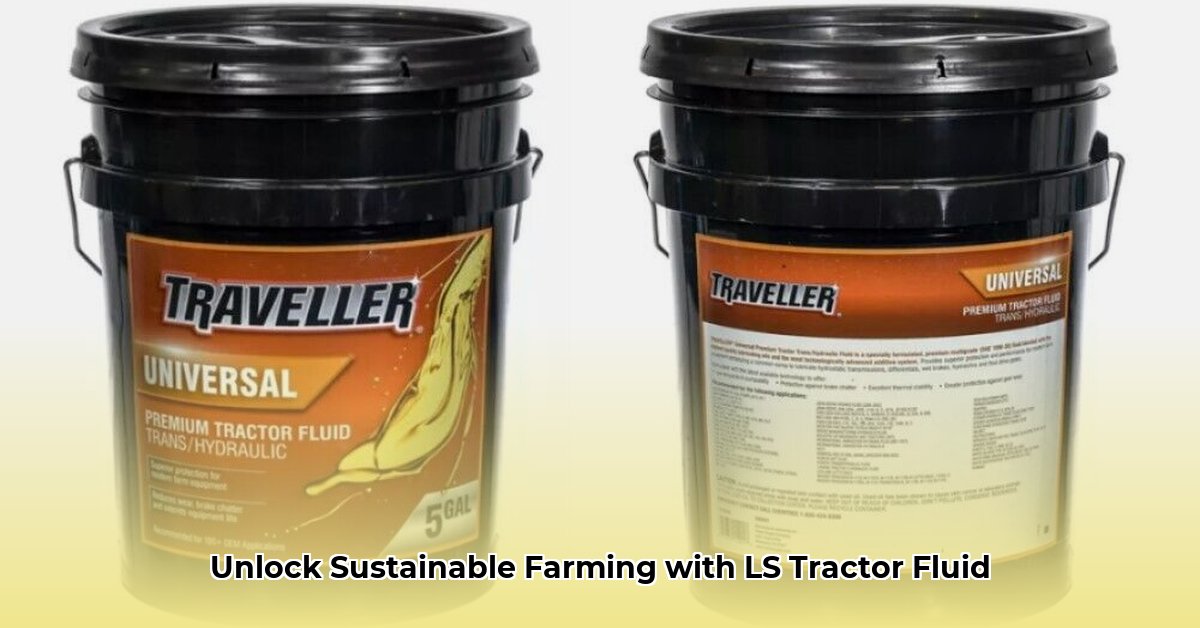
Keeping your LS MT240E-HST tractor running smoothly is crucial for a successful harvest. However, selecting the right hydraulic fluid can be confusing due to conflicting information online and in owner's manuals. This guide provides clear, step-by-step instructions to ensure optimal tractor performance and longevity, contributing to the success of your sustainable farming operation. For maintaining other tractor components, see advice on tire fluid.
Understanding Hydraulic Fluid Specifications
Before diving into maintenance, let's clarify key terms:
API GL-4: (American Petroleum Institute Gear Lubricant 4) This designation indicates the fluid meets specific performance standards for gear and hydraulic applications. It's a crucial specification for your LS tractor.
ISO VG (Viscosity Grade): This number represents the fluid's thickness or resistance to flow. Higher numbers mean thicker fluid. The ideal ISO VG depends on your climate and workload. Conflicting information exists regarding the optimal ISO VG for the LS MT240E-HST; we'll address this later.
Your owner's manual may offer a general recommendation or a range of acceptable ISO VG values. This is common; manufacturers often account for varying operating conditions. The best approach is to consider local climate and typical workload.
50-Hour Maintenance: Filter Replacement and Top-Off
At the 50-hour mark, prioritize preventative maintenance by changing the hydraulic and HST filters. This simple step significantly extends the life of your hydraulic system.
Materials:
- New hydraulic and HST filters (check your owner's manual for correct part numbers).
- Shop-vac (minimizes fluid spillage).
- Clean rags.
- Fresh API GL-4 compliant hydraulic fluid (for topping off).
Steps:
- Locate Filters: Consult your owner's manual to identify filter locations.
- Careful Removal: Gently remove old filters, collecting any spilled fluid. Clean the area around the filter mounts.
- Minimize Spillage: Use the shop-vac to carefully remove any remaining fluid, preventing environmental contamination and reducing waste.
- Installation: Install new filters, tightening securely according to manufacturer instructions.
- Fluid Check: Check your dipstick and top off the hydraulic fluid reservoir with fresh API GL-4 fluid to the correct level.
This 50-hour service is a straightforward preventative measure that helps maintain peak tractor performance. Isn't preventative maintenance more cost-effective than unexpected repairs?
500-Hour Service: Complete Fluid Replacement
After 500 hours, a complete fluid change is necessary. This is where selecting the correct ISO VG is critical.
Materials:
- Correct quantity of fresh API GL-4 hydraulic fluid (consult your owner's manual).
- Drain pan.
- Containers for used fluid.
- Tools for draining and refilling (specified in your owner's manual).
- Method for proper fluid disposal (check local regulations).
Steps:
- Consult Manual: Refer to your owner's manual for precise instructions and fluid capacity.
- Thorough Drainage: Carefully drain the old hydraulic fluid into your containers.
- Responsible Disposal: Dispose of used fluid properly; many auto parts stores and dealerships accept used oil and hydraulic fluid for recycling.
- Refill with Correct Fluid: Use the recommended fluid based on the guidelines below.
- Final Check: Reassemble, start the tractor, and check for leaks. Run briefly to ensure correct operation.
Choosing the Right ISO VG
The optimal ISO VG depends on your operating conditions:
| Climate | Typical Workload | Recommended ISO VG Range |
|---|---|---|
| Hot (above 80°F) | Light to moderate | 32-46 |
| Moderate (60-80°F) | Moderate to heavy | 46-68 |
| Cold (below 60°F) | Heavy or prolonged low-temp use | 68+ |
Consult your owner's manual and local LS Tractor dealership for the most accurate recommendation. Ongoing research continues to refine our understanding of hydraulic fluid performance in various conditions.
Troubleshooting Common Hydraulic System Problems
Even with proper maintenance, issues may arise.
- Leaks: Inspect hoses, connections, and seals for leaks; address these promptly.
- Low Fluid Levels: Regularly check fluid levels; low levels often indicate leaks.
- Unusual Noises: Grinding or whining sounds may indicate internal problems; contact your dealer.
Cost Considerations and Sustainability
While higher-quality fluid might initially cost more, it's an investment in your tractor's longevity. Using the correct fluid prevents premature wear, reducing costly repairs and downtime. This contributes to sustainable farming practices by maximizing equipment life and minimizing waste.
Conclusion: Prioritizing Tractor Maintenance for Sustainable Success
Proper maintenance, including correct hydraulic fluid selection and regular servicing, is essential for maximizing your LS tractor's lifespan and ensuring the long-term success and sustainability of your farming operation. Preventative maintenance is significantly more cost-effective than emergency repairs.